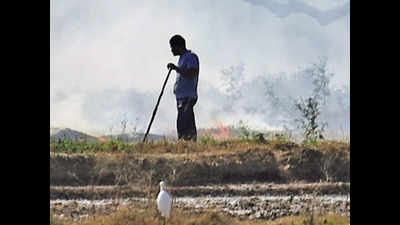- News
- City News
- chandigarh News
- Haryana picks 30 hotspots in each district before paddy harvest
Trending
This story is from September 14, 2020
Haryana picks 30 hotspots in each district before paddy harvest
With procurement of paddy set to start from the first week of October, the Haryana authorities have identified vulnerable hotspots in every district to curb incidents of stubble burning. The deputy commissioners (DCs) of each district have also been apprised about the stubble burning hotspots in their areas to ensure timely action and prevent farmers from burning paddy straw.

Haryana chief secretary Keshni Anand Arora said that in view of coronavirus it is imperative to stop stubble (File photo)
CHANDIGARH: With procurement of paddy set to start from the first week of October, the Haryana authorities have identified vulnerable hotspots in every district to curb incidents of stubble burning. The deputy commissioners (DCs) of each district have also been apprised about the stubble burning hotspots in their areas to ensure timely action and prevent farmers from burning paddy straw.
During last year’s paddy season, Haryana had witnessed around 6,600 stubble burning incidents — identified by Haryana Space Applications Centre (Harsac) —and around 2,000 FIRs were registered.
Haryana managed to reduce incidents of stubble burning by use of deterrents like cancellation of arms licences of farmers found burning stubble in their fields.
S Narayanan, member secretary, Haryana State Pollution Control Board (HSPCB), told TOI that 30 vulnerable hotspots have been identified based on the previous years’ data and patterns in every district. He also confirmed that the main focus is on five districts — Karnal, Kurukshetra, Kaithal, Fatehabad and Sirsa — where highest number incidents related to stubble burning have been reported in the previous years. He added that HSPCB monitoring and educating farmers about ill-effects of stubble burning and action will be taken by the teams of agriculture and other departments at district level.
Narayanan, however, said that like previous year, this year also they are expecting a decline in the number of stubble burning cases.
Haryana chief secretary Keshni Anand Arora recently directed district administrations to ensure ‘zero-stubble’ burning during this paddy season. She said that in view of the spread of coronavirus it is imperative to ensure zerostubble burning in the state because many types of respiratory diseases are likely to spread due to increase in pollution in environment, which can then increase the chances of spreading coronavirus.
Stubble Trouble
Stubble becomes a burning issue when paddy is harvested in Punjab and Haryana in autumn. After paddy harvest, the window for sowing wheat is narrow, leading to a spurt in stubble burning as farmers have next to no time to prepare their fields for the next crop.
Farmers in northwest India, especially these two states, face strong criticism for drastic rise in air pollution during winters due to burning of crop residue. With an average of 20 quintals of paddy straw generated per acre, it is of little or no use to the farmers, who can either plough it back into the soil or dispose it of by burning or put it to some other use. The two state governments are working to ensure it is ploughed back into the soil by providing farmers machinery required for in-situ management of crop residue. And the main focus of the two states is to claw back land under paddy production and ensure farmers grow other crops.
During last year’s paddy season, Haryana had witnessed around 6,600 stubble burning incidents — identified by Haryana Space Applications Centre (Harsac) —and around 2,000 FIRs were registered.
Haryana managed to reduce incidents of stubble burning by use of deterrents like cancellation of arms licences of farmers found burning stubble in their fields.
S Narayanan, member secretary, Haryana State Pollution Control Board (HSPCB), told TOI that 30 vulnerable hotspots have been identified based on the previous years’ data and patterns in every district. He also confirmed that the main focus is on five districts — Karnal, Kurukshetra, Kaithal, Fatehabad and Sirsa — where highest number incidents related to stubble burning have been reported in the previous years. He added that HSPCB monitoring and educating farmers about ill-effects of stubble burning and action will be taken by the teams of agriculture and other departments at district level.
‘Ensure there’s no stubble burning’
Narayanan, however, said that like previous year, this year also they are expecting a decline in the number of stubble burning cases.
Haryana chief secretary Keshni Anand Arora recently directed district administrations to ensure ‘zero-stubble’ burning during this paddy season. She said that in view of the spread of coronavirus it is imperative to ensure zerostubble burning in the state because many types of respiratory diseases are likely to spread due to increase in pollution in environment, which can then increase the chances of spreading coronavirus.
Stubble Trouble
Stubble becomes a burning issue when paddy is harvested in Punjab and Haryana in autumn. After paddy harvest, the window for sowing wheat is narrow, leading to a spurt in stubble burning as farmers have next to no time to prepare their fields for the next crop.
Farmers in northwest India, especially these two states, face strong criticism for drastic rise in air pollution during winters due to burning of crop residue. With an average of 20 quintals of paddy straw generated per acre, it is of little or no use to the farmers, who can either plough it back into the soil or dispose it of by burning or put it to some other use. The two state governments are working to ensure it is ploughed back into the soil by providing farmers machinery required for in-situ management of crop residue. And the main focus of the two states is to claw back land under paddy production and ensure farmers grow other crops.
End of Article
FOLLOW US ON SOCIAL MEDIA











